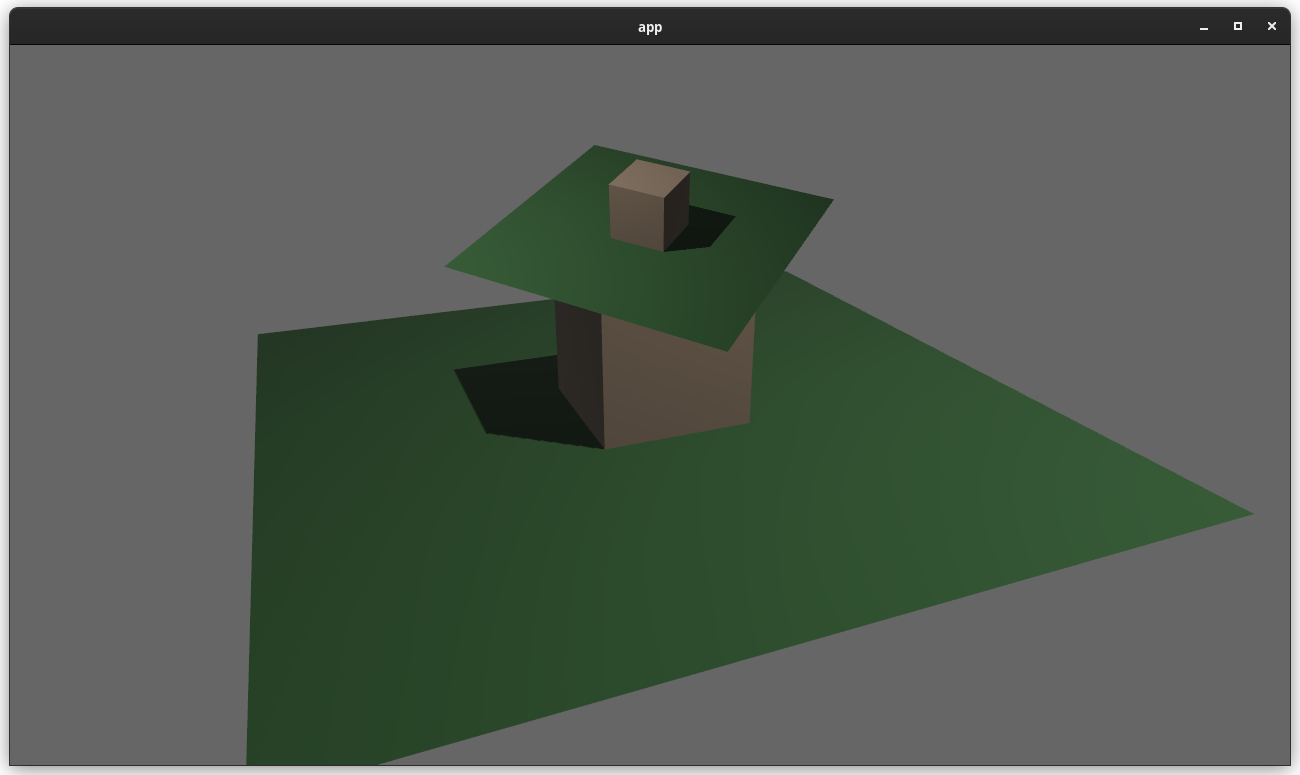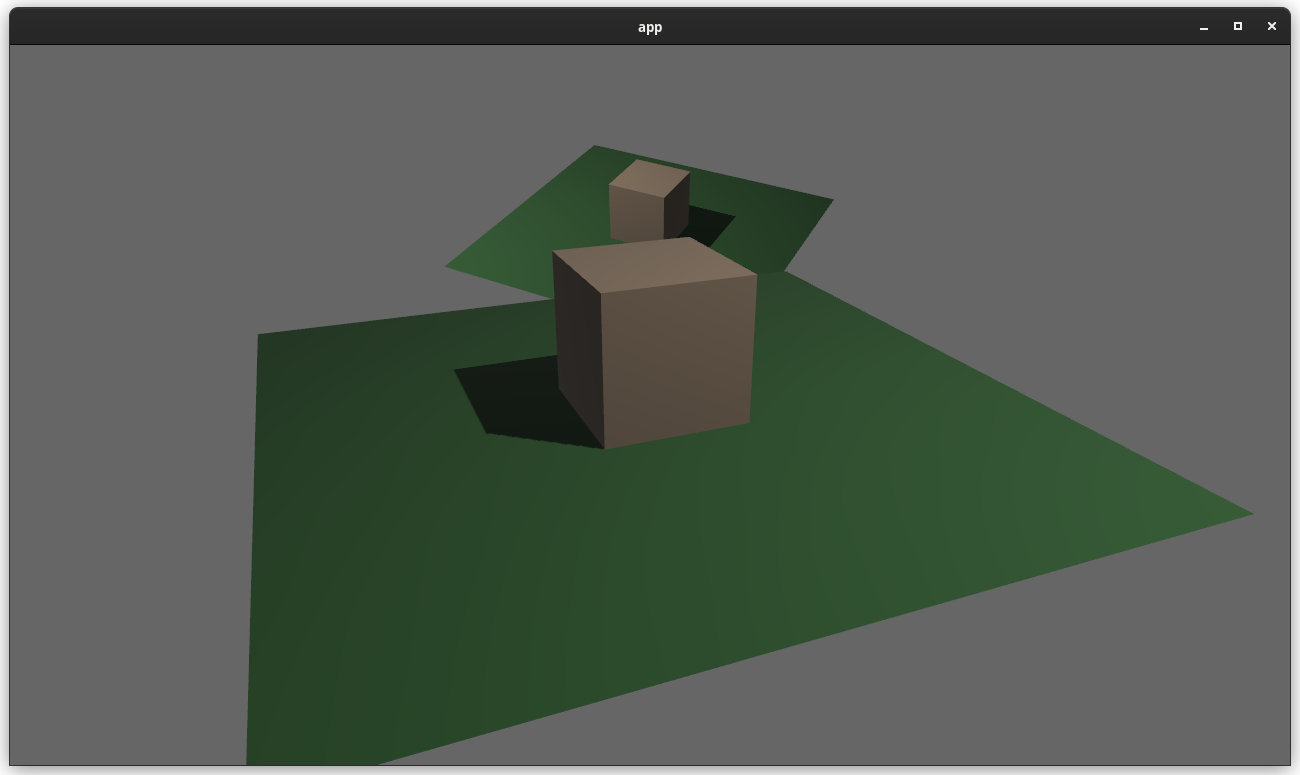mirror of
https://github.com/bevyengine/bevy
synced 2025-02-18 15:08:36 +00:00
# Objective
Users should be able to configure depth load operations on cameras. Currently every camera clears depth when it is rendered. But sometimes later passes need to rely on depth from previous passes.
## Solution
This adds the `Camera3d::depth_load_op` field with a new `Camera3dDepthLoadOp` value. This is a custom type because Camera3d uses "reverse-z depth" and this helps us record and document that in a discoverable way. It also gives us more control over reflection + other trait impls, whereas `LoadOp` is owned by the `wgpu` crate.
```rust
commands.spawn_bundle(Camera3dBundle {
camera_3d: Camera3d {
depth_load_op: Camera3dDepthLoadOp::Load,
..default()
},
..default()
});
```
### two_passes example with the "second pass" camera configured to the default (clear depth to 0.0)

### two_passes example with the "second pass" camera configured to "load" the depth

---
## Changelog
### Added
* `Camera3d` now has a `depth_load_op` field, which can configure the Camera's main 3d pass depth loading behavior.
257 lines
8.7 KiB
Rust
257 lines
8.7 KiB
Rust
//! A custom post processing effect, using two cameras, with one reusing the render texture of the first one.
|
|
//! Here a chromatic aberration is applied to a 3d scene containting a rotating cube.
|
|
//! This example is useful to implement your own post-processing effect such as
|
|
//! edge detection, blur, pixelization, vignette... and countless others.
|
|
|
|
use bevy::{
|
|
core_pipeline::clear_color::ClearColorConfig,
|
|
ecs::system::{lifetimeless::SRes, SystemParamItem},
|
|
prelude::*,
|
|
reflect::TypeUuid,
|
|
render::{
|
|
camera::{Camera, RenderTarget},
|
|
render_asset::{PrepareAssetError, RenderAsset, RenderAssets},
|
|
render_resource::{
|
|
BindGroup, BindGroupDescriptor, BindGroupEntry, BindGroupLayout,
|
|
BindGroupLayoutDescriptor, BindGroupLayoutEntry, BindingResource, BindingType,
|
|
Extent3d, SamplerBindingType, ShaderStages, TextureDescriptor, TextureDimension,
|
|
TextureFormat, TextureSampleType, TextureUsages, TextureViewDimension,
|
|
},
|
|
renderer::RenderDevice,
|
|
view::RenderLayers,
|
|
},
|
|
sprite::{Material2d, Material2dPipeline, Material2dPlugin, MaterialMesh2dBundle},
|
|
};
|
|
|
|
fn main() {
|
|
let mut app = App::new();
|
|
app.add_plugins(DefaultPlugins)
|
|
.add_plugin(Material2dPlugin::<PostProcessingMaterial>::default())
|
|
.add_startup_system(setup)
|
|
.add_system(main_camera_cube_rotator_system);
|
|
|
|
app.run();
|
|
}
|
|
|
|
/// Marks the first camera cube (rendered to a texture.)
|
|
#[derive(Component)]
|
|
struct MainCube;
|
|
|
|
fn setup(
|
|
mut commands: Commands,
|
|
mut windows: ResMut<Windows>,
|
|
mut meshes: ResMut<Assets<Mesh>>,
|
|
mut post_processing_materials: ResMut<Assets<PostProcessingMaterial>>,
|
|
mut materials: ResMut<Assets<StandardMaterial>>,
|
|
mut images: ResMut<Assets<Image>>,
|
|
) {
|
|
let window = windows.get_primary_mut().unwrap();
|
|
let size = Extent3d {
|
|
width: window.physical_width(),
|
|
height: window.physical_height(),
|
|
..default()
|
|
};
|
|
|
|
// This is the texture that will be rendered to.
|
|
let mut image = Image {
|
|
texture_descriptor: TextureDescriptor {
|
|
label: None,
|
|
size,
|
|
dimension: TextureDimension::D2,
|
|
format: TextureFormat::Bgra8UnormSrgb,
|
|
mip_level_count: 1,
|
|
sample_count: 1,
|
|
usage: TextureUsages::TEXTURE_BINDING
|
|
| TextureUsages::COPY_DST
|
|
| TextureUsages::RENDER_ATTACHMENT,
|
|
},
|
|
..default()
|
|
};
|
|
|
|
// fill image.data with zeroes
|
|
image.resize(size);
|
|
|
|
let image_handle = images.add(image);
|
|
|
|
let cube_handle = meshes.add(Mesh::from(shape::Cube { size: 4.0 }));
|
|
let cube_material_handle = materials.add(StandardMaterial {
|
|
base_color: Color::rgb(0.8, 0.7, 0.6),
|
|
reflectance: 0.02,
|
|
unlit: false,
|
|
..default()
|
|
});
|
|
|
|
// The cube that will be rendered to the texture.
|
|
commands
|
|
.spawn_bundle(PbrBundle {
|
|
mesh: cube_handle,
|
|
material: cube_material_handle,
|
|
transform: Transform::from_translation(Vec3::new(0.0, 0.0, 1.0)),
|
|
..default()
|
|
})
|
|
.insert(MainCube);
|
|
|
|
// Light
|
|
// NOTE: Currently lights are ignoring render layers - see https://github.com/bevyengine/bevy/issues/3462
|
|
commands.spawn_bundle(PointLightBundle {
|
|
transform: Transform::from_translation(Vec3::new(0.0, 0.0, 10.0)),
|
|
..default()
|
|
});
|
|
|
|
// Main camera, first to render
|
|
commands.spawn_bundle(Camera3dBundle {
|
|
camera_3d: Camera3d {
|
|
clear_color: ClearColorConfig::Custom(Color::WHITE),
|
|
..default()
|
|
},
|
|
camera: Camera {
|
|
target: RenderTarget::Image(image_handle.clone()),
|
|
..default()
|
|
},
|
|
transform: Transform::from_translation(Vec3::new(0.0, 0.0, 15.0))
|
|
.looking_at(Vec3::default(), Vec3::Y),
|
|
..default()
|
|
});
|
|
|
|
// This specifies the layer used for the post processing camera, which will be attached to the post processing camera and 2d quad.
|
|
let post_processing_pass_layer = RenderLayers::layer((RenderLayers::TOTAL_LAYERS - 1) as u8);
|
|
|
|
let quad_handle = meshes.add(Mesh::from(shape::Quad::new(Vec2::new(
|
|
size.width as f32,
|
|
size.height as f32,
|
|
))));
|
|
|
|
// This material has the texture that has been rendered.
|
|
let material_handle = post_processing_materials.add(PostProcessingMaterial {
|
|
source_image: image_handle,
|
|
});
|
|
|
|
// Post processing 2d quad, with material using the render texture done by the main camera, with a custom shader.
|
|
commands
|
|
.spawn_bundle(MaterialMesh2dBundle {
|
|
mesh: quad_handle.into(),
|
|
material: material_handle,
|
|
transform: Transform {
|
|
translation: Vec3::new(0.0, 0.0, 1.5),
|
|
..default()
|
|
},
|
|
..default()
|
|
})
|
|
.insert(post_processing_pass_layer);
|
|
|
|
// The post-processing pass camera.
|
|
commands
|
|
.spawn_bundle(Camera2dBundle {
|
|
camera: Camera {
|
|
// renders after the first main camera which has default value: 0.
|
|
priority: 1,
|
|
..default()
|
|
},
|
|
..Camera2dBundle::default()
|
|
})
|
|
.insert(post_processing_pass_layer);
|
|
}
|
|
|
|
/// Rotates the cube rendered by the main camera
|
|
fn main_camera_cube_rotator_system(
|
|
time: Res<Time>,
|
|
mut query: Query<&mut Transform, With<MainCube>>,
|
|
) {
|
|
for mut transform in query.iter_mut() {
|
|
transform.rotation *= Quat::from_rotation_x(0.55 * time.delta_seconds());
|
|
transform.rotation *= Quat::from_rotation_z(0.15 * time.delta_seconds());
|
|
}
|
|
}
|
|
|
|
// Region below declares of the custom material handling post processing effect
|
|
|
|
/// Our custom post processing material
|
|
#[derive(TypeUuid, Clone)]
|
|
#[uuid = "bc2f08eb-a0fb-43f1-a908-54871ea597d5"]
|
|
struct PostProcessingMaterial {
|
|
/// In this example, this image will be the result of the main camera.
|
|
source_image: Handle<Image>,
|
|
}
|
|
|
|
struct PostProcessingMaterialGPU {
|
|
bind_group: BindGroup,
|
|
}
|
|
|
|
impl Material2d for PostProcessingMaterial {
|
|
fn bind_group(material: &PostProcessingMaterialGPU) -> &BindGroup {
|
|
&material.bind_group
|
|
}
|
|
|
|
fn bind_group_layout(render_device: &RenderDevice) -> BindGroupLayout {
|
|
render_device.create_bind_group_layout(&BindGroupLayoutDescriptor {
|
|
label: None,
|
|
entries: &[
|
|
BindGroupLayoutEntry {
|
|
binding: 0,
|
|
visibility: ShaderStages::FRAGMENT,
|
|
ty: BindingType::Texture {
|
|
multisampled: false,
|
|
view_dimension: TextureViewDimension::D2,
|
|
sample_type: TextureSampleType::Float { filterable: true },
|
|
},
|
|
count: None,
|
|
},
|
|
BindGroupLayoutEntry {
|
|
binding: 1,
|
|
visibility: ShaderStages::FRAGMENT,
|
|
ty: BindingType::Sampler(SamplerBindingType::Filtering),
|
|
count: None,
|
|
},
|
|
],
|
|
})
|
|
}
|
|
|
|
fn fragment_shader(asset_server: &AssetServer) -> Option<Handle<Shader>> {
|
|
asset_server.watch_for_changes().unwrap();
|
|
Some(asset_server.load("shaders/custom_material_chromatic_aberration.wgsl"))
|
|
}
|
|
}
|
|
|
|
impl RenderAsset for PostProcessingMaterial {
|
|
type ExtractedAsset = PostProcessingMaterial;
|
|
type PreparedAsset = PostProcessingMaterialGPU;
|
|
type Param = (
|
|
SRes<RenderDevice>,
|
|
SRes<Material2dPipeline<PostProcessingMaterial>>,
|
|
SRes<RenderAssets<Image>>,
|
|
);
|
|
|
|
fn prepare_asset(
|
|
extracted_asset: PostProcessingMaterial,
|
|
(render_device, pipeline, images): &mut SystemParamItem<Self::Param>,
|
|
) -> Result<PostProcessingMaterialGPU, PrepareAssetError<PostProcessingMaterial>> {
|
|
let (view, sampler) = if let Some(result) = pipeline
|
|
.mesh2d_pipeline
|
|
.get_image_texture(images, &Some(extracted_asset.source_image.clone()))
|
|
{
|
|
result
|
|
} else {
|
|
return Err(PrepareAssetError::RetryNextUpdate(extracted_asset));
|
|
};
|
|
|
|
let bind_group = render_device.create_bind_group(&BindGroupDescriptor {
|
|
label: None,
|
|
layout: &pipeline.material2d_layout,
|
|
entries: &[
|
|
BindGroupEntry {
|
|
binding: 0,
|
|
resource: BindingResource::TextureView(view),
|
|
},
|
|
BindGroupEntry {
|
|
binding: 1,
|
|
resource: BindingResource::Sampler(sampler),
|
|
},
|
|
],
|
|
});
|
|
Ok(PostProcessingMaterialGPU { bind_group })
|
|
}
|
|
|
|
fn extract_asset(&self) -> PostProcessingMaterial {
|
|
self.clone()
|
|
}
|
|
}
|